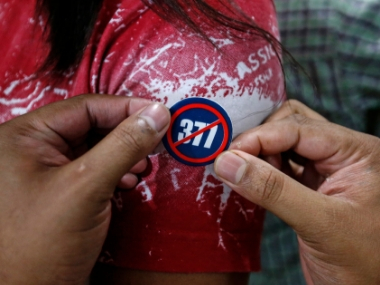Section 377 of the Indian Penal Code in itself has seen several recent challenges since the 1990s in the Indian legal system (and similarly in other countries that contain the same criminal code, such as Singapore). However, its fundamental religious bias and the origins of terms such as “unnatural offences,” or what was meant by that within the precedent system, has not been sufficiently discussed. The wording of the law, under “unnatural offences” and with terminology such as “against the order of nature,” points to the necessity of the historical record in understanding what Macaulay and the Law Commission took as implicit in its four-lined condemnation of alternative sexualities on the subcontinent. [caption id=“attachment_5121681” align=“alignleft” width=“380”] Representational image. Reuters[/caption] Given that same-sex sexual activity had not previously been penalised in 72 countries where Macaulay’s law is now in effect, precedent for this was only established on importing it from a religious and aristocratic 16th Century English context. Thus it is imperative to ask after the origins of such precedent. Investigating Henry VIII’s laws reveal that neither sodomy nor buggery were clearly defined. Henry VIII’s Buggery Act of 1533, as it later came to be known, was repealed and replaced in England by the Offences Against the Person Act of 1828 and later 1861. The 19th Century acts retained the 16th Century terminology but dispensed with the sanctimonious piety, although the law retained a few terms (‘abominable’, ‘buggery’, ‘mankind or with any animal’) that hint at its religious origins. Buggery, like bestiality, fell on a spectrum of sexual acts deemed abominable by European and English ecclesiastical (religious) courts, revealing how Christian beliefs governed English society’s world views. Irrespective of the absence of a substantial definition of Buggery, given the range of sexual practices that could be incriminated under it, and the fact that this criminalisation stemmed from Christian moral codes, Lord Macaulay, head of the first Law Commission tasked with drafting a criminal code for India, instituted an ‘unnatural offences’ clause into the colonial government’s criminal code, termed the Indian Penal Code. Known as Section 377 of the Indian Penal Code, this law draws on the terminology and precedent of the English legal system. Section 377 of the IPC states:
“Unnatural offences: Whoever voluntarily has carnal intercourse against the order of nature with any man, woman or animal shall be punished with imprisonment for life, or with imprisonment of either description for a term which may extend to ten years, and shall also be liable to fine.
Explanation: Penetration is sufficient to constitute the carnal intercourse necessary to the offence described in this section.
It is not necessary to prove that the act was against the will or without the consent of the person upon whom the offence is committed. If that person is consenting, both are guilty of the offence.”
Renaissance scholars note that ‘sodomy’ “include(d) copulation between Satan and humans and between Christians and infidels . . .”. However ‘buggery’ emerges from Christian doctrine of aestheticism which condemned all non-procreative sex. The term derives from the French word ‘bougre’, referencing the Cathars sect, who condemned procreation and were thus accused of promoting non-procreative sexual acts. While the ‘Buggery Act’ relies clearly on ‘spiritual’ authority to condemn a whole range of unnamed practices in the 16th Century, the ‘Offences Against the Person Act’ passed nearly three hundred years later in 1828 and 1861 retains the 16th Century terminology, without the religious undertones. In the 1861 Act, the earlier Buggery Act was codified under ‘unnatural offences’ (Section 15 of the 1828 Act and Section 61 of the 1861 Act). It is this that Macaulay ported over under the guise of precedent essential to a supposedly modern legal system. This brief history highlights the religious nature of sections of the criminal code of not just the secular and democratic country of India, but also the commonwealth countries of Pakistan, Malaysia, Singapore, Bangladesh, Myanmar, Maldives, and Jamaica, as well as the 30-odd other countries for which the Indian Penal Code provides a model for anti-sodomy laws. Not only does the systemic presence of Christian law underwrite the criminal code of a democratic secular nation which does not presume to swear by the religion, it also forms fundamental aspects of declared religious states such as Pakistan where the state religion certainly is not Christianity. Article was first published on Love Camden on 18 September 2017, as ‘ Homosexuality and Criminalisation in India: The Arts Fight Back’ Follow all the LIVE updates from the Supreme Court Section 377 verdict here


)

)
)
)
)
)
)
)
)



